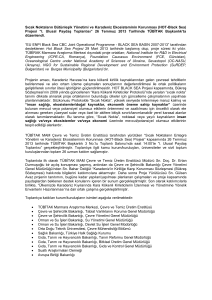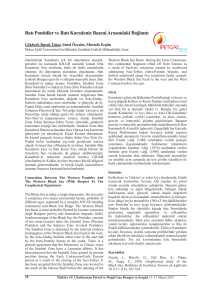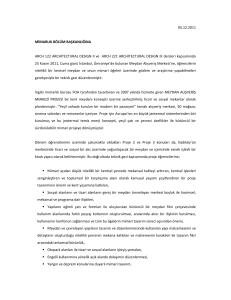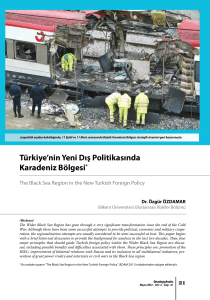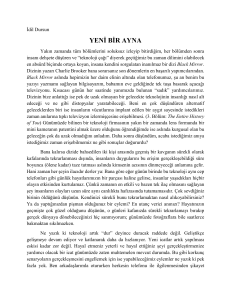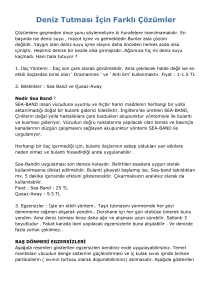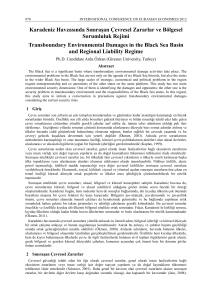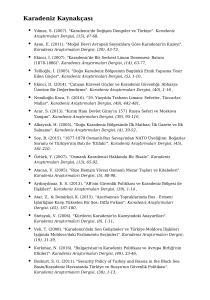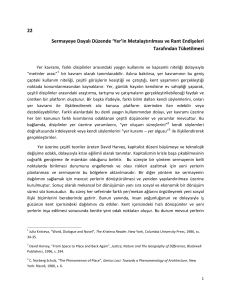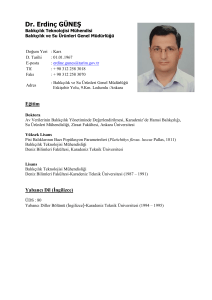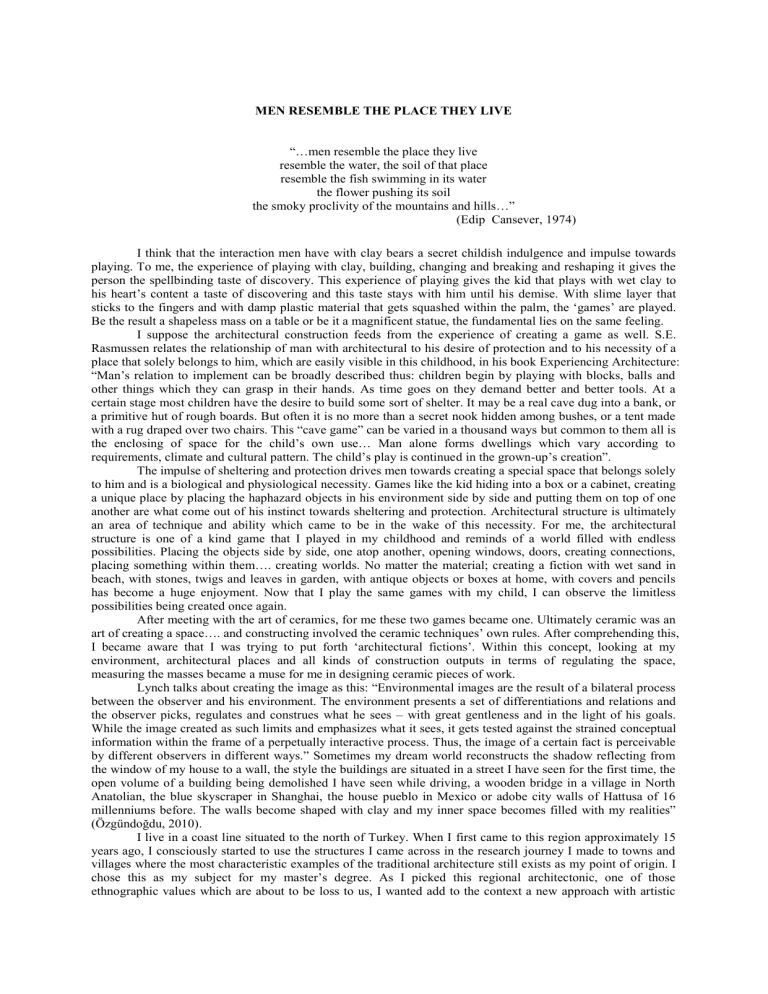
MEN RESEMBLE THE PLACE THEY LIVE
“…men resemble the place they live
resemble the water, the soil of that place
resemble the fish swimming in its water
the flower pushing its soil
the smoky proclivity of the mountains and hills…”
(Edip Cansever, 1974)
I think that the interaction men have with clay bears a secret childish indulgence and impulse towards
playing. To me, the experience of playing with clay, building, changing and breaking and reshaping it gives the
person the spellbinding taste of discovery. This experience of playing gives the kid that plays with wet clay to
his heart’s content a taste of discovering and this taste stays with him until his demise. With slime layer that
sticks to the fingers and with damp plastic material that gets squashed within the palm, the ‘games’ are played.
Be the result a shapeless mass on a table or be it a magnificent statue, the fundamental lies on the same feeling.
I suppose the architectural construction feeds from the experience of creating a game as well. S.E.
Rasmussen relates the relationship of man with architectural to his desire of protection and to his necessity of a
place that solely belongs to him, which are easily visible in this childhood, in his book Experiencing Architecture:
“Man’s relation to implement can be broadly described thus: children begin by playing with blocks, balls and
other things which they can grasp in their hands. As time goes on they demand better and better tools. At a
certain stage most children have the desire to build some sort of shelter. It may be a real cave dug into a bank, or
a primitive hut of rough boards. But often it is no more than a secret nook hidden among bushes, or a tent made
with a rug draped over two chairs. This “cave game” can be varied in a thousand ways but common to them all is
the enclosing of space for the child’s own use… Man alone forms dwellings which vary according to
requirements, climate and cultural pattern. The child’s play is continued in the grown-up’s creation”.
The impulse of sheltering and protection drives men towards creating a special space that belongs solely
to him and is a biological and physiological necessity. Games like the kid hiding into a box or a cabinet, creating
a unique place by placing the haphazard objects in his environment side by side and putting them on top of one
another are what come out of his instinct towards sheltering and protection. Architectural structure is ultimately
an area of technique and ability which came to be in the wake of this necessity. For me, the architectural
structure is one of a kind game that I played in my childhood and reminds of a world filled with endless
possibilities. Placing the objects side by side, one atop another, opening windows, doors, creating connections,
placing something within them…. creating worlds. No matter the material; creating a fiction with wet sand in
beach, with stones, twigs and leaves in garden, with antique objects or boxes at home, with covers and pencils
has become a huge enjoyment. Now that I play the same games with my child, I can observe the limitless
possibilities being created once again.
After meeting with the art of ceramics, for me these two games became one. Ultimately ceramic was an
art of creating a space…. and constructing involved the ceramic techniques’ own rules. After comprehending this,
I became aware that I was trying to put forth ‘architectural fictions’. Within this concept, looking at my
environment, architectural places and all kinds of construction outputs in terms of regulating the space,
measuring the masses became a muse for me in designing ceramic pieces of work.
Lynch talks about creating the image as this: “Environmental images are the result of a bilateral process
between the observer and his environment. The environment presents a set of differentiations and relations and
the observer picks, regulates and construes what he sees – with great gentleness and in the light of his goals.
While the image created as such limits and emphasizes what it sees, it gets tested against the strained conceptual
information within the frame of a perpetually interactive process. Thus, the image of a certain fact is perceivable
by different observers in different ways.” Sometimes my dream world reconstructs the shadow reflecting from
the window of my house to a wall, the style the buildings are situated in a street I have seen for the first time, the
open volume of a building being demolished I have seen while driving, a wooden bridge in a village in North
Anatolian, the blue skyscraper in Shanghai, the house pueblo in Mexico or adobe city walls of Hattusa of 16
millenniums before. The walls become shaped with clay and my inner space becomes filled with my realities”
(Özgündoğdu, 2010).
I live in a coast line situated to the north of Turkey. When I first came to this region approximately 15
years ago, I consciously started to use the structures I came across in the research journey I made to towns and
villages where the most characteristic examples of the traditional architecture still exists as my point of origin. I
chose this as my subject for my master’s degree. As I picked this regional architectonic, one of those
ethnographic values which are about to be loss to us, I wanted add to the context a new approach with artistic
sensitivity. I had carried their wooden architectural characteristics of most unique properties to my ceramic
works of art and had reported this interpretation. Though later on I only studied on technological topics in my
doctoral research and applications, I noticed that in these artistic works that I created, the souls of these
structures found their most profound places in my ceramics. When I evaluate my works in my individual
exhibition in 2014 generally in terms of design, I see that this architectural perspective and interpretation style
starting from 15 years ago changed and thrived until today.
Eastern Black Sea Architecture is the work of the socio-cultural society different from the various
residential areas of Turkey, the work of the tectonics insofar as the different nature conditions permit and the
work of sense of lodgment. Thus the Eastern Black Sea is probably the most characteristic region of the
Anatolian Architecture in terms of unique findings, solutions and gained success in the wooden-based tectonics.
It is a region of numerous interlinked valleys, steep slopes, high and arduous peaks with their shadows
blackening the sky, forests covering each and every corner, waters bellowing at the feet of valleys, smothering
and humid weather, rich plant cover, every color and styles of color green. Thus the main building material of
the region is timber.
Kuban says: “We, who are aware of the magnificent possibilities of the contemporary technology, are
shocked at with how little material all the big structures and with how primitive methods they were built until the
19th century. Another thing as shocking as that is the morphologies achieved with these possibilities.” The
diversity of morphologies achieved with the timbers used in the traditional architecture in the Black Sea region is
remarkable and literally gives them the stamp ‘a work of art’.
If I were to make a self-assessment of how the geological structure of this region, that said how its
traditional architecture finds itself in my ceramic pieces of work, I can say that certain characteristics are main
molders. Wooden-framed wall textures, mounting-dismantling aspects of the structures, serender (hórreo) which
is a specific type of storehouse, high and arduous peaks, bridges and see.
My studies are mostly simple prisms. For me, this is the simplest shape of an architectural form. Thus
the surfaces of prism structures are the areas that give me the opportunity of analyzing the structure of wall
systems. Wooden framed walls of the traditional Black Sea architecture are signified as the relief atop the
surfaces of my ceramic works. Building walls are constructed with stiles and girders, and the spaces are filled
either with stones or with wood. I prefer composing the wooden packed walls as collages in the surfaces of my
works. I take pieces from certain areas of the wooden walls and sometimes create windows in the middle of the
rhythmic stiles and sometimes place small boxes in their areas filled with stones. “Niche filling” (stone filling) is
the most sophisticated construction technique in the Eastern Black Sea. Apart from it being the structural wall of
stone and wood, it also brings to the table a new texture and color aesthetic, a certain sense of modulation and
insertion technique, these are very hard to find somewhere else” (Sözen, Eruzun). Together with the partly
blackened color effect of wood, these buildings may just be continuing the liveliness of the tree as a part of the
nature. Thus in my most studies I try to make the red-brown color characteristic of wood appear as a natural stain.
In the traditional Black Sea architecture, systems that were created with placing the timbers of various
thicknesses or rougher los horizontally atop one another are used especially in high uplands where the summer
time is spent. In this system, there is no secondary carrier element, wood is both the carrier and the protector
against exterior factors just as in the stone or brick loadbearing wall construction. While constructing masonry
buildings, nails are mainly not needed thanks to these practical solutions. With this simple plan, the structures
gain the ability of being dismantled from somewhere and be remounted at somewhere else. We use the verb
install instead of build and the verb dismantle instead of demolish. I am of the idea that this process has a similar
side to the game fiction I mentioned above. Thereby in most of my works, the pieces are mobile. Cubes and
prismatic structures are installed, dismantled and are reinstallable. Thus a changing composition can be
mentioned in these. I prefer regulating the units over and over again based on the need for accommodation or for
aesthetics from a different angle.
Serender (Hórreo) has a different importance in terms of construction and aesthetic and with its unique
look, is one of the indicators of Eastern Black Sea Architecture. Closed economy of the region forces the usage
of serender possessing a cool and natural air conditioning so that the products produced once a year would be
preserved until their consumption. Thus in the coastal regions where the raindrop rates are high, there are more
serender. Serender has a simple plan, enclosing storage part built atop the feet where the product is preserved
and the arbor part stationed at one point around the structure or surrounding it completely. Within its residential
composition, serender resembles a small house with its roof, arbor and its plan. But with its solid geometry
rising on top of the posts, the examples with which the master builder shows off his talent are perceived as a
‘unique form’ within the general texture. This unique model takes place as a special motif along with
architectural harmony in my work; a cubic structure standing atop simple feet. Because I rather have its interior
be shown, placing a small window and looking into it would be my choice. Here you enter a small chamber.
Sometimes a family welcomes you, sometimes the light oozing out of the window if no one is home.
This geographical area is where the mountains and hills with peaks and steep slopes take place.
Therefore houses are built on top of these steep slopes. When you look above to take a look at the houses, you
cannot help but ask yourself: How did they go up there and build houses? The people of this region adapted
themselves to the harsh geographical conditions and shaped their each and every production and life style
accordingly. They are powerful and determined. In my prismatic structures where I tried to capture this feeling, I
tried to make use of the sense of height. Because the porcelain structure becomes deformed in the firing, these
prisms are ever so little inclined towards a direction. This supports the sense of steep slopes reachable by
climbing that I wanted to capture. Also, I prefer using the static view of the architectural texture collages or stone
filling walls in the surfaces.
There is an adjective we use for the people of Black Sea: “Hırçın” (Meaning ill-tempered). With the
Prussian blue color of Black Sea, with its ups and downs, it is unpredictable. Be it summer or winter, it is as if it
is singing a ballad of freedom with its wavy sea noise. Especially when the ill-tempered waves hit the shares in
winters, the rocks act as though they give in against its power. In summer, this sea is actually calm despite the
ever so blowing wind and you fade away to the sky in this tempered sea surface. Suddenly it starts to temper and
shocks everyone. The ballads of this region always mention this sea, but mostly through complaint. Black Sea
participates in my works with its color and waves. In my porcelain works cobalt is the color of the sea. So that its
voice would be heard somewhere between the architectural texture collages, I prefer using the waves. Some of
my works are portrayed with temper. Light beams of the sun are signified as white lines in curl. In some other
ones, the waves get tempered in the surface of the Prussian blue sea.
In my own work, with my own way of interpreting, I try to represent the data that I had found by
following the trail of the ancient ruins of a time where the nature was the one to be harmonized with. Men
resemble the place they live. I am so happy and thankful that I had the chance to get something out of the
beauties of the places where I had lived, not matter how little.
References
Çakır, A. Feyza, “The Commentary of the Black Sea Region Architecture On the Ceramics Surfaces and Forms”
MA Thesis, Hacettepe University, 2000.
Kuban, Doğan, “Mimarlık Kavramları”, Yapı ve Endüstri Merkezi Yayınları, İstanbul, 1998.
Lynch, Kevin, “The Image of the City”, MIT Press, 1960.
Özgündoğdu, A.F., “Architectural Reflections: An Autocritical Essay”. The 2nd International Ceramic Art
Forum Proceedings Book, Zibo, PRC, 2010.
Rasmussen, Steen Eiler, “Experiencing Architecture”, MIT Press, 1964.
Architecture photographs by Eda BALCI. For more photos, please visit http://feyzaceramics.wordpress.com/
(Pictures)
İNSAN YAŞADIĞI YERE BENZER
“…İnsan yaşadığı yere benzer
O yerin suyuna, o yerin toprağına benzer
Suyunda yüzen balığa
Toprağını iten çiçeğe
Dağlarının, tepelerinin dumanlı eğimine…”
İnsanın çamur ile iletişiminde çocuksu bir haz ve oyun oynama dürtüsünün gizli olduğunu düşünürüm.
Bana göre çamurla oyun kurma; inşa etme, değiştirme ve bozma ve tekrar biçimlendirme deneyimleri kişiye
muhteşem bir keşif duygusu tattırır. Bu oyun deneyimi ıslak toprakla doyasıya oyun oynayan bir çocuk için
keşfetmenin hazzını tattırır ve ömrü boyunca bu duygu onda saklı kalır. Parmaklara bulaşan balçık katmanı ve
avuç içinde eziliveren nemli plastik malzeme ile ‘oyun’ oynanır: Sonuç masadaki biçimsiz bir kütle olsun ya da
muhteşem bir heykel, temelde hep aynı duygu vardır.
Mimari inşanın da oyun kurma deneyimlerinden beslendiğini düşünüyorum. S.E. Rasmussen,
Experiencing Architecture adlı kitabında insanın mimari ile ilişkisini çocukluk döneminde açıkça görünen
korunma güdüsüne ve kendine ait özel bir alan yaratma ihtiyacına bağlıyor: “Man’s relation to implement can be
broadly described thus: children begin by playing with blocks, balls and other things which they can grasp in
their hands. As time goes on they demand better and better tools. At a certain stage most children have the desire
to build some sort of shelter. It may be a real cave dug into a bank, or a primitive hut of rough boards. But often
it is no more than a secret nook hidden among bushes, or a tent made with a rug draped over two chairs. This
“cave game” can be varied in a thousand ways but common to them all is the enclosing of space for the child’s
own use… Man alone forms dwellings which vary according to requirements, climate and cultural pattern. The
child’s play is continued in the grown-up’s creation”.
Canlılara özgü barınma ve korunma güdüsü, insanı biyolojik ve psikolojik olarak ihtiyacı olan,
kendisine ait, özel bir boşluk yaratma çabasına iter. Çocuğun bir kutunun, dolabın içine saklanması, çevresindeki
gelişigüzel nesneleri yan yana, üst üste yığarak kendine ait bir mekan oluşturması gibi oyunlar onun barınma ve
korunma içgüdüsü ile kurduğu bir oyundur. Mimari yapı, bu ihtiyacın sonucunda oluşmuş bir teknik ve beceri
alanıdır nihayetinde. Benim için mimari inşa çocukluğumda oynadığım bir başka oyundur ve bana sonsuz
olanaklarla dolu bir dünyayı hatırlatır. Nesneleri yan yana dizmek, üst üste yığmak, pencereler, kapılar açmak,
bağlantılar kurmak, içlerine bir şeyleri yerleştirmek…dünyalar yaratmak. O an ne varsa: Sahilde ıslak kumla,
bahçede taşlarla, dallar ve yapraklarla, buluntu nesnelerle ya da evde kutularla, örtülerle, kalemlerle bir kurgu
oluşturmak büyük bir zevk olagelmiştir. Şimdi oğlumla aynı oyunları oynarken yine sonsuz olanakların yeniden
yaratıldığını izleyebiliyorum.
Seramik sanatı ile tanıştıktan sonra benim için bu iki oyun bir araya geldi. Nihayetinde seramik bir
boşluk yaratma sanatı idi…ve inşa etmek seramik tekniklerinin kendi özel kurallarını barındırıyordu. Bunu
kavradıktan sonra ortaya “mimari kurgular” çıkarmaya çalıştığımın bilincine vardım. Bu anlamda çevreme,
mimari mekanlara ve her türlü inşa ürününe, boşlukların düzenlenmesi, hacimlerin hesaplanması açısından
bakmak seramik eserlerimin tasarımında bana esin kaynağı oldu.
Lynch, imgeyi yaratmak konusunda şöyle söylüyor: “Çevresel imgeler, gözlemciyle çevresi arasındaki
iki yönlü bir işlemin sonucudur. Çevre, bir takım farklılıklar ve bağıntılar sunar, gözlemci de – büyük bir
yumuşaklıkla ve kendi amaçlarının ışığında – gördüklerini seçer, düzenler ve bunlara anlam verir. Bu biçimde
oluşturulan imge, görülen şeyi sınırlar ve vurgularken, kendisi de sürgit etkileşimli bir işlem çerçevesinde
süzgeçten geçirilen algısal bilgiye karşı sınanır. Böylece, belli bir gerçeğin imgesini değişik gözlemciler değişik
biçimde algılayabilirler”. Kimi zaman evimin penceresinden duvara yansıyan gölge, ilk defa
geçtiğim bir
sokaktaki binaların dizilişi, arabayla geçerken gördüğüm yıkılmakta olan bir evin açık hacmi, Kuzey Anadolu
köyündeki bir ahşap köprü, Shanghai’daki mavi gökdelen, Meksika’daki pueblo evi ya da 16 binyıl öncesi
Hattuşa’sının kerpiç kent surları hayal dünyamda yeniden inşa ediliyor. Duvarlar kil ile biçimleniyor, inner space
kendi gerçeklerimle doluyor” (Özgündoğdu, 2010)
Türkiye’nin kuzeyinde bulunan bir sahil şeridinde yaşıyorum. Yaklaşık 15 yıl önce bu bölgeye ilk defa
geldiğimde geleneksel mimarinin en karakteristik örneklerinin hala var olduğu kasaba ve köylere yaptığım
inceleme gezisinde karşılaştığım beni çok etkilemiş olan yapıları seramiklerimde bilinçli olarak çıkış noktası
olarak kullanmaya başladım. Bu konuyu mastır tezimde konu olarak seçtim. Anadolu'nun kaybolmakta olan
etnografik değerlerinden biri olan bu bölge mimarisini çalışma konusu olarak seçerken, konuya sanatsal
duyarlılıkla yeni bir yaklaşım oluşturmak istemiştim. Son derece özgün örneklerinin var olduğu ahşap mimari
karakterlerini seramik eserlerime taşımış ve bu yorumu raporlamıştım. Daha sonraları doktora araştırmalarım ve
uygulamalarımda tamamen teknolojik konularda çalışmış olsam da, ortaya çıkardığım sanatsal eserlerde bu
yapıların ruhunun
seramiklerime derinden yerleştiğini fark ettim. 2014 yılında açtığım kişisel sergimdeki
eserleri tasarım anlamında genel olarak değerlendirdiğimde görüyorum ki, 15 yıl öncesinden başlayan mimari
bakış açısı ve yorum tarzı değişerek ve zenginleşerek bugüne kadar yansımış.
Doğu Karadeniz Mimarisi, Türkiye’nin çeşitli yerleşim alanlarına göre farklı sosyo-kültüre sahip
toplumun, yine farklı doğal koşulların elverdiği yapı sanatı ve yerleşme anlayışının eseridir. Bu yüzden Doğu
Karadeniz, ahşaba dayalı yapı sanatında kendine özgü buluşları ve çözümleri ile ulaştığı başarı açısından
Anadolu Mimarlığının belki de en karakteristik yöresidir. Birbirine giren sayısız vadi, dik yamaçlar, gökyüzüne
silueti düşen yüksek ve sarp zirveler, yamaçları örten ormanlar, vadilerin dibinde köpürerek akan sular, buğulu
ve rutubetli hava, zengin bir bitki örtüsü, her türlü renk ve yeşil rengin çeşidini barındıran’ bir bölgedir.
Dolayısıyla bölgenin ana yapı malzemesi ahşaptır.
Kuban şöyle diyor: “19. yüzyıla gelene kadar, bütün büyük yapı eylemlerinin ne kadar az sayıda
malzeme ve ne kadar ilkel tekniklerle yürütüldüğü, çağdaş teknolojinin nefes kesen olanaklarından haberdar olan
bizler için şaşırtıcıdır. Aynı derecede şaşırtıcı olan, bu olanaklarla ulaşılan biçim zenginliğidir" Karadeniz
bölgesindeki geleneksel mimaride kullanılan ahşap ile ulaşılan biçim zenginliği çok çarpıcıdır ve adeta bu
yapılara bir sanat eseri değeri katar.
Bu bölgenin jeolojik yapısının ve dolayısıyla geleneksel mimarisinin seramik eserlerimde nasıl
belirdiğine dair bir öz değerlendirme yapacak olursam, belli karakterlerin ana biçimlendirici olduklarını
söyleyebilirim: Ahşap iskeletli duvar dokuları, yapıların kurulup-sökülebilme özellikleri, özel bir depo biçimi
olan serenderler, yüksek ve sarp zirveler, köprüler ve deniz.
Çalışmalarım çoğunlukla yalın prizmalar biçimindedir. Bu, benim için mimari bir formun en basit
halidir. Dolayısıyla prizma yapıların yüzeyleri, duvar sistemlerinin yapısını tahlil ve sentez edebileceğim fırsat
alanlarıdır. Geleneksel Karadeniz mimarisinin ahşap iskeletli duvarları seramik eserlerimin yüzeylerinde rölyef
olarak belirir. Binaların duvarları dikme ve kirişlerle inşa edilir ve boşluklar taş ya da ahşap ile doldurulur.
Ahşap dolgulu duvarları çalışmalarımın yüzeylerinde kolajlar şeklinde kompoze etmeyi tercih ediyorum. Ahşap
duvarların belli bölgelerinden parçalar alıyor, kimi zaman ritmik dikmelerin ortasında pencereler açıyorum, kimi
zaman da taş dolgu bölgelerine küçük kutucuklar yerleştiriyorum. "Göz dolma” (taş dolgu), Doğu
Karadeniz'deki en gelişmiş yapı tekniğidir. Taş ve ahşabın bir yapı duvarını oluşturmasından öte, getirdiği doku
ve renk estetiği, ayrıca belli bir modülasyon fikrini ve ahşap birleşmelerdeki geçme tekniğini başka bir yerde
bulmak oldukça güçtür". (Sözen, Eruzun). Ahşabın yer yer kararmış renk etkisiyle birlikte bu binalar doğanın bir
parçası olarak ağacın canlılığını yaşatmaya devam eder gibidirler. Bu nedenle çoğu çalışmamda ahşabın, kızılkahverengi renk karakterinin doğal bir leke şeklinde belirmesine çalışırım.
Geleneksel Karadeniz mimarisinde, özellikle yazların geçirildiği yüksek yaylalarda çeşitli kalınlıktaki
tahtaların ya da daha kaba tomrukların, köşelerde geçmeler sağlayacak biçimde yatay olarak üst üste
yığılmasıyla oluşturulan sistemler kullanılır. Bu sistemde ikinci bir taşıyıcı eleman yoktur, aynen taş veya tuğla
yığma inşaatta olduğu gibi tahta hem taşıyıcı, hem de dış tesirlere karşı koruyucudur. Yığma binaların inşasında
kullanılan bu akılcı çözümler nedeniyle çivi kullanımına pek ihtiyaç duyulmaz. Bu basit planla yapılar sökülerek
bir başka yerde tekrar inşa edilebilme özelliğine sahiptirler. Bu yapılar için inşa etmek yerine kurmak ve yıkmak
yerine, sökmek deyimi kullanılır. Bu işlemin yukarıda da bahsettiğim oyun kurgusuna benzer bir yanı olduğunu
düşünürüm. Bu nedenle bazı işlerimde parçalar mobildir. Küpler ve prizmatik yapılar, kurulur, sökülür, tekrar
kurulabilir. Dolayısıyla bu işlerde değişken bir kompozisyondan söz edilebilir. Konut ihtiyacına göre ya da bir
başka açıdan estetik ihtiyaca göre birimleri tekrar tekrar düzenlemeyi tercih ederim.
Serender konstrüksiyon ve estetik açıdan farklı bir yere sahiptir ve özgün görünümüyle, Doğu
Karadeniz Mimarisinin göstergelerinden biridir. Bölgenin kapalı ekonomisi, yılda bir kez üretilen ürünlerin
tüketilinceye dek sağlıklı korunabilmesi amacıyla, serin ve doğal havalandırmaya sahip serenderlerin
oluşumunda etkendir. Bu nedenle yağışın bol olduğu kıyı kesimlerinde serenderlere daha çok rastlanır. Serender,
basit bir plana sahiptir. Ürünün korunduğu ayaklar üzerine inşa edilmiş kapalı depo kısmı ve yapının bir yönünde
bulunan ya da yapıyı çevreleyen çardak kısmı. Serender, yerleşim kompozisyonu içinde, çatısı, çardağı ve planı
ile küçük bir ev modeli gibidir. Fakat direkler üzerinde yükselen sağlam geometrisiyle, yapı ustasının becerisini
zevkle sergilediği örnekler, genel doku içinde birer 'özgün form' olarak algılanırlar. Bu özgün model
çalışmalarımda mimari bütünlük yanında özel bir motif olarak yer alır. Basit ayaklar üzerinde duran kübik bir
yapı. İçinin özellikle görülmesini tercih ettiğim kutucukların küçük penceresinden içeriye bakılmasını tercih
ederim. Burada küçük bir odaya girersiniz. Kimi zaman bir aile karşılar sizi ya da içeride kimse yoksa
pencereden süzülen ışık.
Bu coğrafi bölge yüksek zirveli, dik yamaçlı dağlar ve tepelerin bulunduğu bir yerdir. Dolayısıyla evler
bu dik yamaçlar üzerine kuruludur. Evlere bakmak için başınızı kaldırıp baktığınızda insan kendine sormadan
edemez: Buraya nasıl çıkmışlar, ev kurmuşlar? Bu bölgenin insanı zor coğrafi koşullara uyum sağlamış ve her
türlü üretim ve yaşam tarzını buna göre biçimlendirmiştir. Bu nedenle güçlü ve kararlıdırlar. Bu duyguyu
yansıtmaya çalıştığım prizmatik yapılarımda da bu yükseklik duygusunu kullanmaya çalışırım. Porselen yapının
pişirimdeki deformasyonu nedeniyle ile bu prizmalar bir yöne hafifçe eğiktir. Bu teknik değişim, benim
hissettirmek istediğim tırmanılarak çıkılan dik yokuşlar duygusunu destekler. Yüzeylerde yine mimari doku
kolajlarını ya da taş dolgu duvarların statik görünümü kullanmayı tercih ediyorum.
Karadeniz için kullandığımız, dilimize yerleşmiş bir sıfat vardır: “Hırçın”. Karadeniz’in koyu lacivert
rengiyle, bir durgun bir coşkun haliyle kestirilemez bir hali vardır. Yaz ya da kış, bu dalgalı deniz gürültüsüyle
özgürlük türküsü söyler gibidir. Özellikle kışları hırçın dalgalar kıyılara vurdukça kayalar bu güç karşısında
teslim olur gibidir. Yazları bu deniz rüzgarına göre bir an sakindir, menevişlenen deniz yüzeyinde gökyüzüne
dalar gidersiniz. Bir anda köpüklenir ve insanı şaşkına çevirir. Bu bölgenin türkülerinde mutlaka denizinden söz
edilir, çoğu zaman sitemle. Karadeniz çalışmalarımda rengiyle ve dalgalarıyla yer bulur. Porselen
çalışmalarımdaki kobalt, denizin rengidir. Mimari doku kolajlarının arasında bir yerlerde sesinin duyulması için
dalgaları kullanmayı tercih ederim. Kimi çalışmalarım ise menevişle bezelidir. Güneşin ışıltıları kıvrım kıvrım
beyaz çizgiler halinde belirir. Kimi eserlerde de dalgalar lacivert denizin yüzeyinde köpüklenir.
Tabiata uyumlu bir yaşamın sürdüğü eski zamanların kalıntılarının izini sürerek bulduğum verileri
eserlerimde kendi yorumumla yaşatmaya ve yansıtmaya çalışıyorum. İnsan yaşadığı yere benzermiş. Kendi
adıma yaşadığım yerin güzelliklerinden biraz olsun bir şeyler alabilme fırsatım olduğu için mutluyum.

